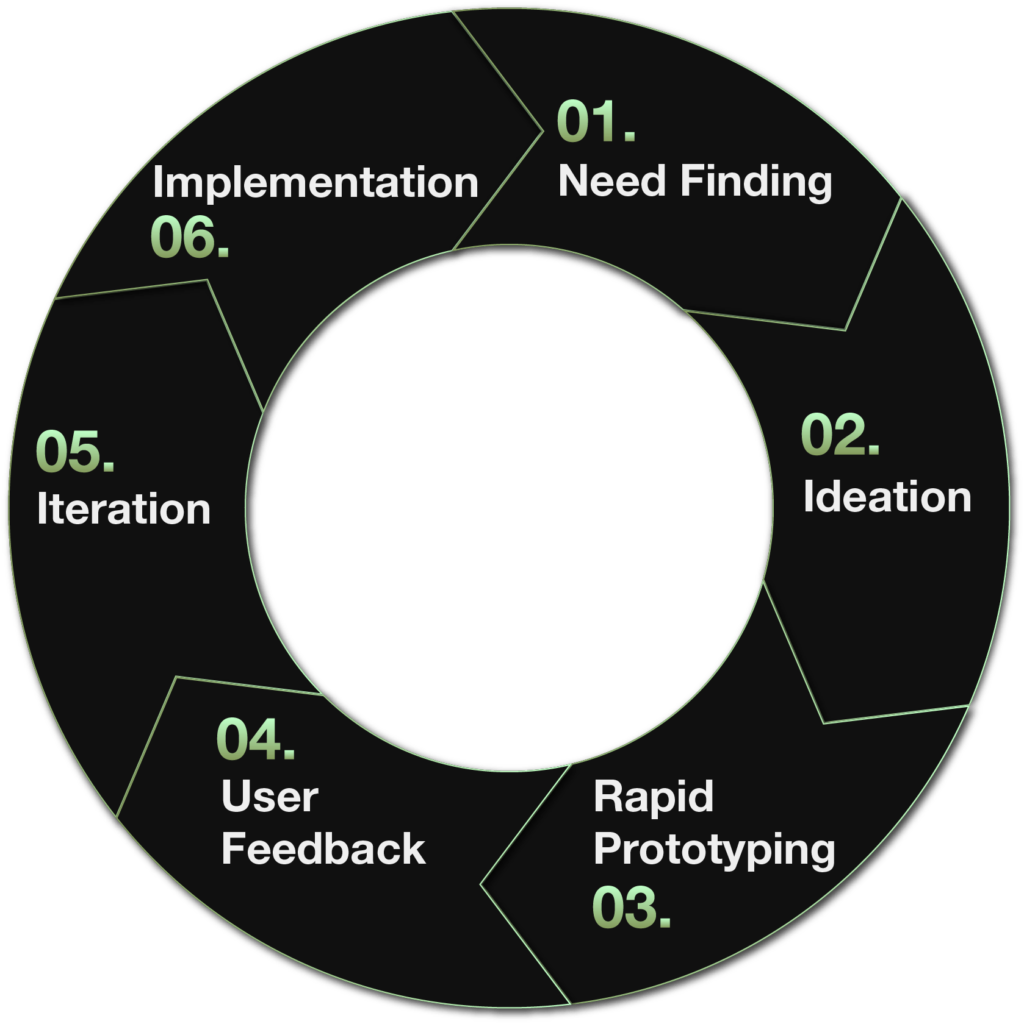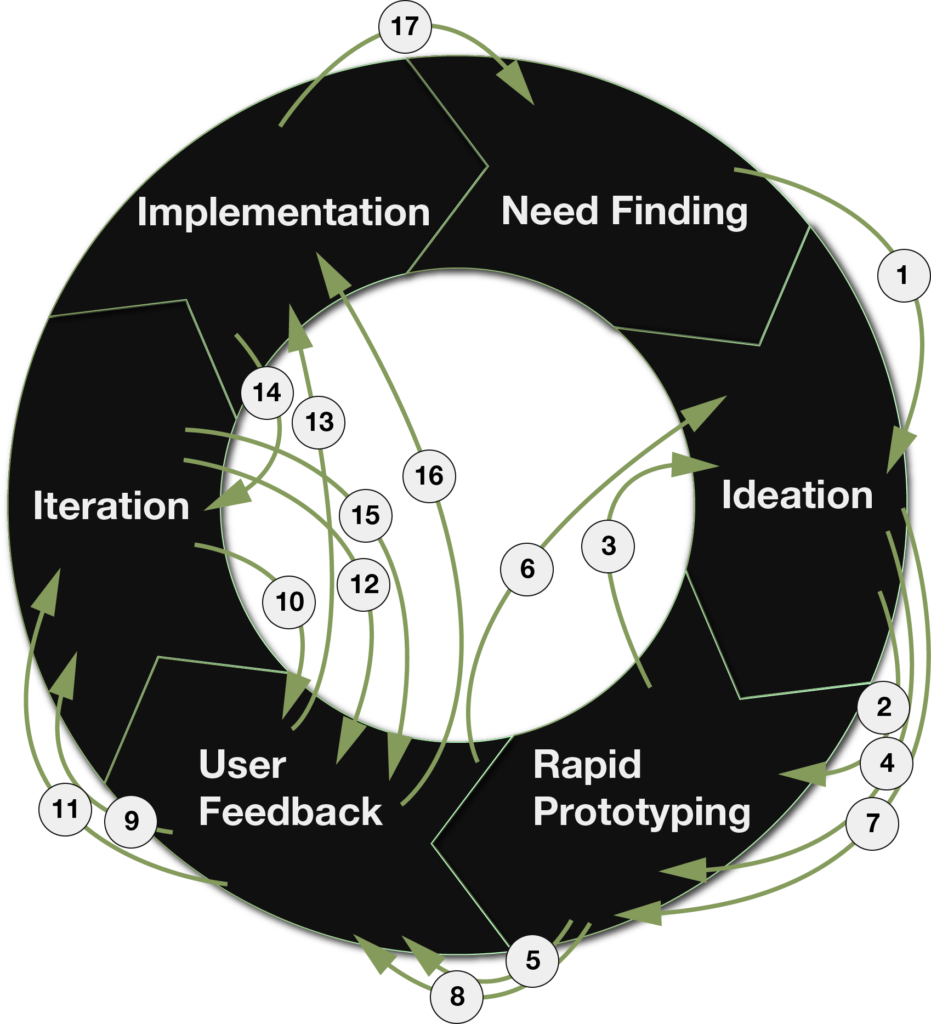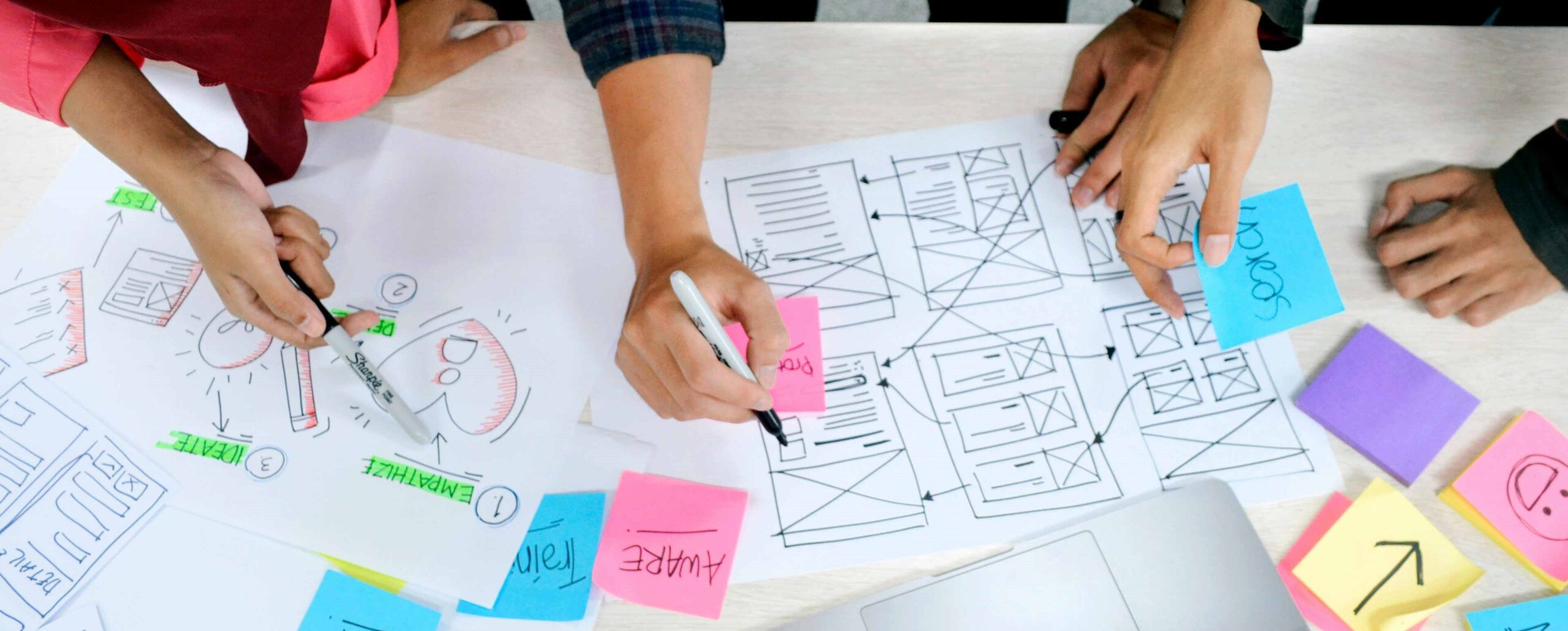I can honestly say that the human-centered design process has changed my life. What started as me trying to learn more about how to be an effective product designer led to a way of thinking that has had a lasting impact and has benefited me in more ways than I can explain.
The human-centered design process is a long-proven process for innovative thinking. I’ve noticed that many people seem to think that this process is only for product designers, but that’s a little like saying that knives are only for professional chefs. Although designers may have put labels to various steps and started teaching this process in a more structured way, they didn’t create this way of thinking, and I think you’ll find that it can be a helpful process for anyone who wishes to be more innovative.
The steps of the human-centered design process are need finding, ideation, rapid prototyping, user feedback, iteration, and implementation. If you google the human-centered design process, you might come across charts showing that this is a cyclical process, like the one here:

Having worked through this process many times, I’d argue that this chart would be a more accurate representation:

And sometimes it feels like this:

But don’t let that scare you. Design is about testing hypotheses and adapting based on your findings. When you break it down, the steps are actually quite simple.
1. Need Finding
When we begin a new project, we need to make sure we have a thorough understanding of the problem that we’re trying to solve. This means observing as users perform the task at hand. It means interviewing users, asking important questions (Conducting successful interviews is a bit of an art and a science. More on that in a future post.). This even means trying the task yourself, fully immersing yourself in the user’s experience.
It’s important to understand the differences between these actions, as each provides you, the designer, with a different insight. For example, you can get plenty of important information out of a user interview, but when a task is second nature to someone, they often do things while completing the task without even realizing it. This means that they’ll leave out key details when answering questions, making the other need-finding methods essential.
Why it’s important: If you think you already fully understand the problem, trust me, you’re wrong (more on being wrong later). I’ve seen this first step skipped on countless occasions, primarily because it’s assumed that the actual problem is already well known and the client, executive, or even the designer him/herself doesn’t want to spend the time and money to do proper research that to them seems unnecessary. It’s pretty impressive how many times I’ve heard “We don’t need to do that. We already know the issue. We just need to move forward.” The issue with this is that the person who hires you to design a solution often doesn’t understand the problem themselves. Even if they’re an “expert in their field”.
I noticed this when I was working to design a medical device with a team of engineers. The surgeon who hired us to design the device came to us with a list of requirements based on his experiences. However, we quickly realized that surgeons were not going to be the primary users of the device, and we needed to speak with nurses, caregivers, and patients. When we did, we found far more issues than had been explained to us previously. We learned that surgeons, nurses, caregivers, and patients each faced their own unique challenges, and they know surprisingly little about what one another is dealing with. Had we designed a device that was intended to be used at home by a caregiver based on the suggestions of the surgeon, we would’ve designed a device that would’ve never been used.
The takeaway: Don’t make assumptions. Take the time early on to learn from each user of your potential product, and do this before you begin developing ideas. For all you know, your solution might not even be a product. It may be a form of education or policy reform. Better to learn early and avoid wasting time and resources.
2. Ideation
Okay, so you’ve put in the work and have a good grasp of the problem at hand (hopefully). Now it’s time to generate ideas. This is where divergent and convergent thinking become very important. Begin by developing as many ideas as you can. It’s okay for some of them to be a bit wild or infeasible. Just get your ideas down. Once you’ve got plenty of ideas down, you can begin to converge them, combining ideas and narrowing them down to those which appear to be the most effective and the most feasible.
Why it’s important: Think back to your first serious romantic relationship (I swear I’m going somewhere with this). If your experience was anything like mine, you met your first girlfriend/boyfriend, you got very excited about the idea of being in a relationship, you probably fell in love very quickly, and you put absolutely everything into making that relationship work for as long as you could because you were too inexperienced to realize that the two of you weren’t compatible or to recognize when the relationship had become unhealthy. The result was probably your first real heartbreak, and it was a doozy (If you’re still with your first love, this analogy might not land. Sorry.).
Not unlike that first relationship, many young designers have a tendency to fall in love with their first idea. But more often than not that first idea isn’t a very good one. They think they’ve “figured it out”. They’re going to be rich, famous, and cure cancer (Okay. Slight exaggeration. But they’re excited.), so they sink all of their time and resources into developing a minimum viable product as quickly as possible. What they eventually realize is that their idea doesn’t actually work, or it’s too expensive/difficult to make, or they were trying to solve the wrong problem (they ideated before doing step 1). The result is heartbreak and a sense of hopelessness not unlike our first relationship.
Using divergent and convergent thinking, where you come up with as many ideas as possible early and then narrow them down, avoids wasting resources and keeps the heartbreak to a minimum.
The Takeaway: Don’t fall in love with your first idea. It’s probably not as good as you think it is (and that’s okay). Do your best to keep an open mind, and treat every idea as a hypothesis that needs to be tested (This will result in less heartbreak. Trust me.). Start by creating many ideas and then narrow them down to the most promising.
03. Rapid Prototyping
On to step 3. So you’ve got some initial ideas that seem promising, but remember, these are just hypotheses that need testing. In order to test them, you need to first build them. These early prototypes should be rough. They shouldn’t be fully functional. They’re designed to fail (yes, you read that correctly). You’ll hear many designers refer to these prototypes as “fail fast prototypes” or “pretotypes”. They’re meant to help you learn as much as possible as quickly as possible.
For example, you might first make a handheld device out of a piece of foam to understand what size the product needs to be. Or you might create a “kiosk” out of a few pieces of plywood and an ipad with some fake buttons to see how users will want to interact with your product. In my first ever product design studio, I was working to design an automatic curtain retractor: basically a wire wrapped around the curtain that would retract into a box mounted next to the window sill. In order to test the experience, I attached a spool of fishing line to a drill bit, wrapped the line around a curtain-sized piece of fabric, and hid myself behind the curtain. Quite literally a “man behind the curtain” effect.
Why It’s Important: Creating these quick and dirty prototypes allows you to test key hypotheses early so that you don’t waste valuable time and resources. I really like the term “fail fast prototypes” for these, because it emphasizes the fact that failure is not a bad thing. Failure is an opportunity to learn. The goal is to fail as quickly and as often as possible so that you can learn quickly and be successful with future iterations.
The Takeaway: Spend as little time as possible building each early prototype. You want to do just enough to test your hypotheses and no more. Perfectionism is the enemy of progress.
04. User Feedback
Unless you’re going to run your business and be your only customer (I highly don’t recommend this as a business model), you are NOT your user. Going to market with a product that nobody wants is very expensive and leads to the death of many companies. The only way to avoid this is to make sure that your product is of value to the user, and the only way to determine that is to continually seek feedback from said user.
In reality, this isn’t step 4. It’s step 1.5, 2.5, 3.5, etc., because if you’re doing product design correctly, you’re repeatedly collecting feedback throughout the process to make sure you’re on the right track. Putting your prototype in the hands of your potential user will quickly tell you what works and what doesn’t. If you’re further along in the process and have a functional prototype, then also make sure to test it in context. If at any point you’re asking yourself “should I check with a user on this?”, the answer is probably “yes”.
It’s worth noting that you can get user feedback on more than just your product’s functionality, appearance, etc. Asking users “how much would you pay for this?” helps you understand your market and determine what needs to be done to make sure your product is profitable.
Why It’s Important: This is literally the only way to make sure you’re designing something that will be helpful to users and profitable for your business. Please don’t skip this.
The Takeaway: Obtain user feedback as often as needed during the design process, and be strategic about how you obtain that feedback. Make sure to both ask and observe (see step 1).
05. Iteration
The human-centered design process is an iterative process. I like to think of it as a series of failures that occur until you arrive at a compelling solution. You come up with an idea (a theory). you test that theory. You use what you learned to adjust your idea. You test it again. You rinse and repeat. It’s actually much more fun than I’m making it sound. So throughout this process, you’re adjusting your design until you “get it right”. The most important thing here is to make your adjustments based on the user feedback you’ve gathered. Sometimes this means making a slight adjustment, and sometimes it means making a major pivot. Either is fine, as long as you’re working toward an effective solution.
Why It’s Important: If you become emotionally attached to your first idea and take it all the way to market, you will likely waste a lot of valuable time and money developing a “solution” that nobody wants. In order to be innovative, you need to repeatedly develop and test ideas.
The Takeaway: Acquire user feedback and iterate as often as necessary, but make sure you have a reason for each iteration. Note that iterations should happen more quickly in early stages (rapid prototyping) and more slowly in later stages, as the product gets closer to being market-ready.
06. Iplementation
If you’ve completed the process above successfully, then you likely have a fully functional prototype with positive user feedback. Congrats! The last step in the process is implementation, or preparation for market launch. For a physical product, this might mean adjusting the design for manufacturability and ease of assembly (though you should try to keep DMFA principles in mind throughout the design process), forming a list of approved suppliers, developing an online storefront, etc.
Why It’s Important: The end goal is a product, not a project. If you’re taking your own product to market, then you need to complete several steps in order to sell your product successfully. If you’re designing a product for a client, then they’ll want it to be as market-ready as possible: not just functional and desirable, but manufacturable, marketable, and profitable.
The Takeaway: Implementation is about taking what you’ve designed and making it market-ready. There is a broad range of tasks that could be involved in this process. Just make sure to maintain regular communication with your industry partners: your manufacturer, your marketer, your sales team, etc. They’re there to help you.
07. Rinse & Repeat
How many products do you know where the version sold today is exactly the same as the version that was first released? Probably not too many. The world is constantly changing, and the user needs that you discovered early in the design process may not exist later on. It’s important to revisit your design and to repeat the human-centered design process as often as necessary, creating new versions to ensure that your product doesn’t fall into obsolescence. This may seem like a lot of work (and it is), but it’s important to think of products and businesses as living, breathing entities that need to adapt in order to thrive. Otherwise, you’ll end up trying to sell a Blackberry in 2024 (If you don’t know what a Blackberry is, that’s kind of the point, and I feel very old. Please google it).
Lessons & Benefits
Perspective: The human-centered design process teaches you to stop making assumptions. Instead of assuming what someone else is experiencing, the process forces you to put yourself in others’ shoes (maybe literally, if you’re designing footwear). I’ve found this to be helpful in not just product design and marketing, but in handling work conflicts and other relationships.
Humility: The human-centered design process, by nature, humbles you. This iterative process involves a series of failures until you arrive at an effective solution. If you’re need-finding and acquiring user feedback correctly, then you’re constantly reminded of how much you don’t know or understand. This allows you to be confident in the hard-earned knowledge that you have, while maintaining an open mindset that allows you to listen and continue learning.
Understanding Failure: The human-centered design process teaches you to see failure as a learning experience. When you finally have the idea that you believe is going to solve the problem that you’ve been working on for so long, you get incredibly excited…but then you might test that idea only to realize that it doesn’t work the way you had imagined, resulting in intense frustration. Emotional highs. Emotional lows. But as you get more and more used to the process, you begin to shift how you handle these highs and lows. You learn how to avoid becoming emotionally attached to your ideas, especially those which have yet to be tested. You’ll also find that your emotional lows (when your ideas don’t work out) become less detrimental as you realize that regardless of whether an idea is proved correct or incorrect when tested, you now know more than you did before, so you’re headed in the right direction.
Entrepreneurship: Having worked for multiple early-stage startups, I’ve noticed a lot of parallels between the human-centered design process and the type of decision making and innovation that tends to make startups successful. One of the most important traits of an entrepreneur is adaptability: treating your ideas as hypotheses and pivoting from them, altering them, or pushing forward with them only once they’ve been tested. Many startups fail because a founder or cofounder has become emotionally attached to an idea, convinced themselves that they’re correct, and refused to test or pivot from their idea.
I hope you found this post helpful. Admittedly, it ended up being significantly longer than I had planned, but I wanted to really dive into the “why” behind the process, which not many other posts seem to do. Please don’t hesitate to reach out with any questions or feedback that you may have! This post is an early-prototype that I’m testing, and I plan on there being more iterations 😉


